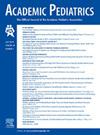2009-2023年毕业儿科住院医师开始担任总住院医师的特点。
IF 2.8
3区 医学
Q1 PEDIATRICS
引用次数: 0
摘要
目的:探讨儿科住院医师毕业后升任总住院医师的比例及其与升任总住院医师相关的特点。方法:对2009 - 2023年全国毕业生随机抽样的15年AAP调查数据进行分析。住院医生被问及他们在住院后直接开始的职位以及他们的人口统计学和项目特征。我们使用χ2线性关联来检验历年开始担任首席职位的趋势,并使用多变量逻辑回归来检验与开始担任其他职位相比,开始担任总住院医师职位的人口统计学和项目特征之间的关联。结果:年平均有效率为53.4%。总的来说,7812名住院医生中有983人报告开始担任总住院医生职位;各年比例稳定(2009年为12.8%,2023年为11.7%,p=0.41)。在多变量分析中,开始总住院医师职位与几个特征有关。最强的关联是医学院的位置和种族。毕业于美国医学院的住院医师比国际毕业生获得首席职位的几率更高(调整后的优势比[aOR]=1.52, 95%可信区间[CI]=1.20-1.94)。亚裔居民(aOR=0.54, 95% CI=0.43-0.66)、其他种族和民族(aOR=0.57, CI=0.36-0.91)和西班牙裔居民(aOR=0.74, CI=0.57-0.95)担任首席职位的几率低于白人居民。黑人居民的患病几率也低于白人居民,但差异无统计学意义(aOR=0.77, CI=0.55-1.07)。结论:1 / 8的儿科住院医师报告开始担任总住院医师,在美国医学院和白人毕业生中更为常见。本文章由计算机程序翻译,如有差异,请以英文原文为准。
Characteristics of Graduating Pediatric Residents Starting Chief Resident Positions, 2009–2023
Objective
Examine proportion of graduating pediatric residents starting a chief resident position after residency and characteristics associated with starting a chief position.
Methods
We analyzed 15 years of American Academy of Pediatrics survey data collected from national random samples of residents graduating from 2009 to 2023. Residents were asked about the position they were starting directly following residency and their demographic and program characteristics. We used χ2 linear association to examine trends in starting a chief position across years and multivariable logistic regression to examine associations of demographic and program characteristics with starting a chief resident position compared to those starting other positions.
Results
Response rate averaged across years was 53.4%. Overall, 983 of 7812 residents reported starting chief resident positions; the proportion was stable across years (12.8% in 2009, 11.7% in 2023, P = .41). In multivariable analysis, starting a chief resident position was associated with several characteristics. The strongest associations were medical school location and race and ethnicity. Residents who graduated from a US medical school had higher odds than international graduates of starting a chief position (adjusted odds ratio [aOR] = 1.52, 95% confidence interval [CI] = 1.20–1.94). Residents who identified as Asian (aOR = 0.54, 95% CI = 0.43–0.66), Other race and ethnicity (aOR = 0.57, CI = 0.36–0.91), and Hispanic (aOR = 0.74, CI = 0.57–0.95) had lower odds than white residents of starting a chief position. Black residents also had lower odds than white residents, but it was not significantly different (aOR = 0.77, CI = 0.55–1.07).
Conclusions
One in 8 graduating pediatric residents report starting chief resident positions, more commonly among US medical school and white graduates.
求助全文
通过发布文献求助,成功后即可免费获取论文全文。
去求助
来源期刊

Academic Pediatrics
PEDIATRICS-
CiteScore
4.60
自引率
12.90%
发文量
300
审稿时长
60 days
期刊介绍:
Academic Pediatrics, the official journal of the Academic Pediatric Association, is a peer-reviewed publication whose purpose is to strengthen the research and educational base of academic general pediatrics. The journal provides leadership in pediatric education, research, patient care and advocacy. Content areas include pediatric education, emergency medicine, injury, abuse, behavioral pediatrics, holistic medicine, child health services and health policy,and the environment. The journal provides an active forum for the presentation of pediatric educational research in diverse settings, involving medical students, residents, fellows, and practicing professionals. The journal also emphasizes important research relating to the quality of child health care, health care policy, and the organization of child health services. It also includes systematic reviews of primary care interventions and important methodologic papers to aid research in child health and education.
 求助内容:
求助内容: 应助结果提醒方式:
应助结果提醒方式:


